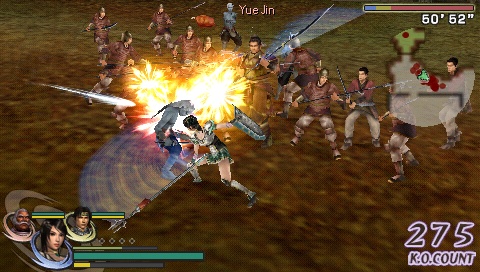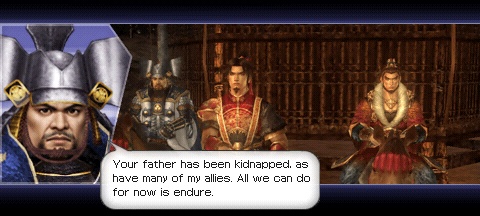If the Dynasty Warriors franchise is to be commended for anything, it should be for its utter unwillingness to evolve--it has absolutely perfected the art of remaining static in a landscape of constant flux. Warriors Orochi continues this long and dubious practice by melding the worlds of Dynasty Warriors with its Japanese offshoot Samurai Warriors, and the result is a game that the faithful it caters to time and time again will surely enjoy immensely. If, on the other hand, you do not enjoy brainless button mashing, laughably one-dimensional gameplay, and a severely aged combat system, you're better off running for the hills.

In case you've somehow managed to avoid the Warriors games, the Dynasty series takes historical characters from China's Warring States period, dresses them up colorfully, gives them comically oversized weapons, and makes them kinda-sorta-not-really re-create famous battles. Samurai Warriors has the same premise, only it takes place in Japan's Sengoku period instead. In Warriors Orochi, the evil, time- and space-warping serpent-sorcerer Orochi takes the heroes and locales from both series and brings them together, making the classic blunder of getting involved in a land war in Asia. Why? He's bored and wants to "test himself" in battle against these legendary warriors, because, presumably, playing with their action figures wasn't satisfying enough.
Thus begins the biggest, most unapologetic fan service crossover since Kingdom Hearts. There are four story campaigns to play through, each of which starts you off with a different group of characters that have a different ultimate goal, but unless you're well versed in the interpersonal relationships between the various characters as previously established (or to a much lesser extent, the actual history behind them), these stories will likely be incomprehensible to you. But that's OK, because they're all simply excuses to justify sending you wading hip-deep through hundreds upon hundreds of useless, nameless goons anyway.
At its heart, this is what Warriors Orochi is all about: the wanton destruction of thousands of hopelessly outgunned and outclassed lives. You're so much more powerful and well defended than the average soldier with a shelf life of zero that combat is an experience akin to shooting deer in a barrel. From beginning to end, battles are nothing more than thumb-tiring button mashers with little to no variation. Your running kill count at the end of a mission will usually float around the 500 mark, and though initially this is a fun power trip, once you realize how shallow and repetitive it is, the affair will quickly sour.
To its credit, Warriors Orochi tries to mix things up just a tiny bit. First off, it employs a three-person team system that lets you mix and match the game's 77 unlockable characters into a party of three, but this feature is ultimately unsatisfying and ill-implemented. You control only one of your warriors at a given time, and when you change one out for another, they magically swap places. The others don't otherwise assist you or even appear on the battlefield, and there aren't any combo attacks or tag-team moves. The other small difference between Orochi and its predecessors is the pre-battle setup, which lets you distribute bonus experience among your characters or spend it upgrading your weapons through a simple fusion system. Simply pick two weapons, and with their powers combined you form a new one.
Outside of the story campaigns, there is the obsessive-compulsive catch-'em-all aspect of recruiting all the warriors and unlocking all their gallery art and weapons, and there's also a Free mode that lets you play through any of the game's missions with any team of warriors you choose. You can also play two-player co-op with a friend via ad hoc Wi-Fi should you find a willing participant.

Warriors Orochi's graphics are uneven. The main characters are reasonably well detailed and animated, especially in their overly dramatic attacks, but the peons that make up the overwhelming majority of your enemies are not--the fact that there are only about five different types of enemies throughout the game is also a bit disconcerting. The environments are similarly drab and overused, and every swamp, grassland, and building looks nearly identical to every other swamp, grassland, and building. The few cutscenes that do appear are nicely animated, but the comic-book-style scenes peppered throughout are hilariously awful and goofy. Voice acting is as terrible as you might expect, and the game is accompanied by a ridiculous techno soundtrack.
When it's all said and done, if the thought of battling both Lu Bu and Keiji Maeda in the same game makes you squeal with delight, Warriors Orochi was definitely made for you. But everyone else is well advised to keep their distance from this pointless and frequently unfun button masher.